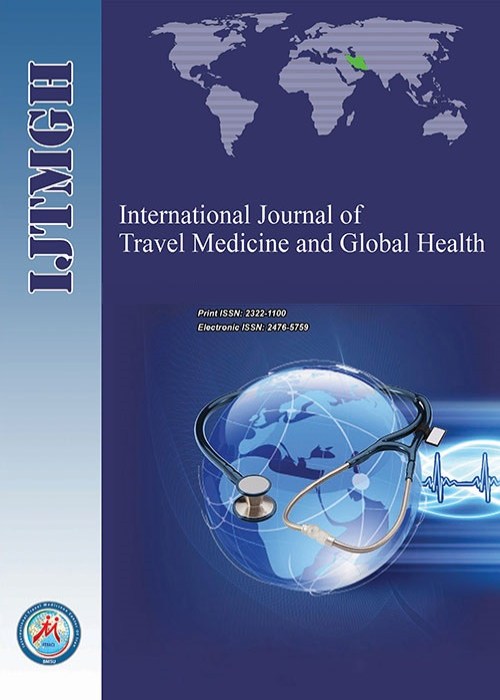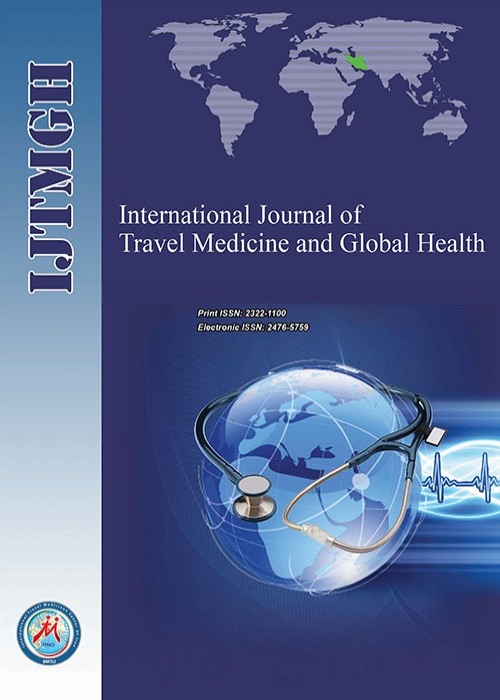فهرست مطالب

International Journal of Travel Medicine and Global Health
Volume:11 Issue: 2, Spring 2023
- تاریخ انتشار: 1402/04/10
- تعداد عناوین: 8
-
-
Pages 252-259Background
During the service period, employees face a wide variety of organizational problems and issues, leading to decision-making based on their knowledge and mental models to take appropriate actions. The aim of this study was to document and record the empirical knowledge of how to provide, organize, and use the human resources of the selected Universities of Medical Sciences in the face of the Covid-19 crisis.
MethodsThe present study used documentary research and questionnaires to find research orientation, application, and evaluation, research philosophy of understanding phenomena, inductive research approaches, research strategy for case study, exploratory and descriptive purpose, one-section time horizon, and the method used for data collection. After collecting data, Excel software (version, 2019) and MaxQDA (version 2020) were used to analyze the data.
ResultsResults from the present empirical study led to the identification and extraction in seven dimensions of the incident, problem, decisions, output and outcome, suggestions, scenario and pattern, and lessons learned from human resource empiricism of selected Universities of Medical Sciences.
ConclusionResults from this study can be used as a basis for managerial planning in the implementation of experience documentation for human resource management.
Keywords: Human resources, COVID-19, lessons learned, Empiricism -
Pages 260-266Background
One of the recommended treatment methods for covid-19 is herbal treatments, which, if used, can be used as an effective preventive or supportive treatment in the treatment plan of patients with covid-19. PHR160 spray is combination of cineole, menthol, safran, safranal , crocin that each of these substances effects on respiratory diseases alone.
AimInvestigating the effectiveness of PHR-160 spray, in the treatment of Covid-19.
MethodsThe present study is a multicenter, double-blind, randomized clinical trial study, which was conducted in 4 medical centers. The study population includes all hospitalized patients with covid-19 who met the study inclusion criteria. The data collection tool was a checklist including: 1- demographic information, 2- vital signs, symptoms, CT scan changes, drug side effects (neural, cardiac and respiratory) at the beginning of admission and from the first to 10th day.
ResultThere was no significant difference between the intervention and control groups in the study of demographic variables, vital signs, symptoms, CT scan changes, and drug side effects before using PHR-160 spray (P>0.05). Also, after using PHR-160 spray for ten days, there was no significant difference in in the admission to the intensive care unit, and patient mortality in the two groups (P>0.05)
ConclusionBased on the results , PHR-160 spray has no beneficial effects in controlling the symptoms of patients with covid-19 and cannot play a effective role in improving the patient's condition and reducing the complications caused by the disease.Keywords: PHR-160 spray , Covid-19 , treatment , patient.
Keywords: PHR-160 spray, COVID-19, treatment, Patient -
Pages 269-279
Varicella Zoster Virus (VZV) is an alpha herpes virus that can conceal itself and produce shingles in addition to generating chicken pox. Varicella is a highly contagious illness brought on by vesicular skin sores, contamination, and maybe to a lesser extent, the propagation of the aerosolized virus. In comparison to children, adults with varicella had a much higher rate of primary VZV infection death. Different nations produce the varicella vaccines known as (Varivax; ProQuad; Merck & Co.), (Varilrix; Priorix-tetra; GSK), (Okavax; Biken, by Sanofi Pasteur), and (SuduVax; Green Cross). The amount of HDC passes, specific antibiotics included to assure sterility, stabilizers, and other minor components vary between different vaccines. The spread of the virus can be decreased dramatically by the widespread use of the varicella vaccine, particularly in a worldwide vaccination program. The World Health Organization suggested varicella vaccination in 1998 for nations where the illness poses a serious threat to public health. Nevertheless, many nations delayed the introduction of the universal varicella vaccine due to worries about the disease spreading to older populations, an increase in elderly herpes zoster, and cost-effectiveness. The purpose of the current research is to review varicella vaccination programs and their global effect.
Keywords: Varicella zoster virus, Vaccination programs, Global Health -
Pages 280-285
IntroductionSedative medications are widely used in intensive care unit patients. Decreased peripheral blood oxygen saturation (SPO2) is one of the common cases in patients with COVID-19. This study aimed to evaluate the effect of Dexmedetomidine on Peripheral oxygen saturation among COVID-19 pneumonia.MethodsSixty patients were randomly divided into two intervention groups (n=30) and control (n=30). Patients in the intervention group received dexmedetomidine with a bolus dose of 1 µ/kg/h for 10 minutes and then with a dose of 0.2 µ/kg/h to achieve a RASS score of -2 to +1. Patients in the control group received sedation drugs such as benzodiazepines, opium, or propofol according to the routine of the center. The well-known Richmond Stimulation and Sedation Scale (RASS) was used to evaluate patient sedation. ResultsData analysis has shown that the changes in systolic and diastolic blood pressure and breathing rate are not significantly different between the two groups of patients (P>0.05). Patients in the intervention group have higher SPO2 compared to control group patients from 72 hours after starting Dexmedetomidine without any considerable adverse effect (P<0.01).ConclusionThe potential sedation effect of dexmedetomidine can be attributed to the improvement in lung mechanics due to better relaxation in the thorax. Improvement in SpO2, and mental status (from agitated to calm) of patients which could be due to dexmedetomidine.
Keywords: COVID-19, dexmedetomidine, peripheral oxygen saturation -
Pages 286-295
Dental tourism, or traveling abroad for dental treatment, has gained popularity in recent years due to cost effective , availability of advanced comprehensive dental procedures, and accessibility to dental care. This scientific paper is to provide a bibliometric analysis of dental tourism research and highlight the extension, development, and trends in the field. The study uses bibliometric techniques to analyze scientific publications related to dental tourism, published between 2010 to 2021, using PubMed database. The analysis provides an overview of the publication output, authorship patterns, international collaborations, citation analysis, and research themes. The study found that dental tourism has become an increasingly popular research topic, with a steady increase in the number of publications over the past two decades. The USA and the UK are the leading countries in terms of publication output and citation impact, with a growing number of studies from emerging economies such as India, Turkey, and Thailand. The study also identified key research themes in the field, including patient motivations, quality of care, ethical considerations, and economic implications. The study concludes by discussing the implications of the findings for policy makers, practitioners, and future research.
Keywords: Travel Medicine, BIBLIOMETRICES, GLOBAL DENTAL HEALTH CARE -
Pages 296-301Introduction
Obesity is known as a chronic disease with increased body fat reserves. The prevalence of obesity in young people is increasing. This study was conducted to investigate the obesity status among students participating in the Science Olympiad in different provinces of Iran.
MethodsThe present study was a descriptive-analytical study that was conducted on 92 teenage boys who participated in the Scientific Olympiad. Sampling was done by the available and purpose-based methods. Data collection was done through a researcher-made questionnaire including personal information and physical information. Physical data included height, weight, body mass index, body fat percentage, and waist and hip circumference measurements (WHR), which were measured and recorded by a researcher. The results were compared using SPSS20 via descriptive and inferential statistical tests.
ResultThe results of the study showed that the majority of participants in the Olympiad were in high school and had participated in the Olympiad for the first time. The average body mass index (BMI) of Olympiad students in the provinces of the country was within the normal range. The results of the body mass index (BMI) and WHR results showed that there was a significant difference between the 5 separate observation provinces (p=0.028 and p=0.018, respectively). But in the examination of body fat percentage, the results showed that there is no significant difference between the 5 separated provinces.)p>0.05)
ConclusionThe results of the present study showed that the average body mass index of adolescent boys in eastern Iran is higher than in other provinces. Also, the WHR of boys in the south is higher than in other provinces. Therefore, it seems necessary to pay attention to and prevent obesity in these areas.
Keywords: Obesity, Overweight, Adolescent -
Pages 302-310Introduction
Due to high neonatal, maternal mortality and adverse pregnancy outcome, Covid-19 in neonates is concerned. This study aimed to determine the prognostic factors for in-hospital mortality in neonates with Covid-19.
MethodsThis retrospective cross-sectional study (February-November 2020) was performed on infected neonates (<60 days) who were clinically diagnosed as Covid-19 and were hospitalized in Covid-19 wards in Shiraz University of Medical Sciences affiliated hospitals, southern Iran. Data were extracted from the patients' medical files, and were gathered in a data collecting form; including demographic characteristics, laboratory and clinical outcome. The patients were categorized as survivor and non-survivors groups, and then were compared.
ResultsTotally, 96 neonates were enrolled. The mean±SD of age was 13.01±10.88 days, and most of them were in the age group of 6-15 days (33.3%). Fifty-nine (61.5%) was male. The mortality rate was 12.5%. Lower gestational age (P=0.031), and the more frequency of having underlying diseases (P=0.010) was observed in non-survivors. The most signs and symptoms were respiratory distress (58.3%), lethargy (46.9%), and poor feeding (37.5%). Pulmonary radiological involvement was more in non-survivors (P<0.001), and it was more severe in these patients (P<0.001). The results of Multivariate Logistic Regression Model showed that only receiving IVIG (OR=20.2, P<0.001) was the independent predictor factor for in-hospital mortality in these patients.
ConclusionsThe in-hospital mortality was obtained as 12.5% in the current study, and only receiving IVIG was the independent predictor factor for in-hospital mortality in neonates with Covid-19.
Keywords: COVID-19, Epidemiology, Infant, Mortality, Prevalence, Prognosis


